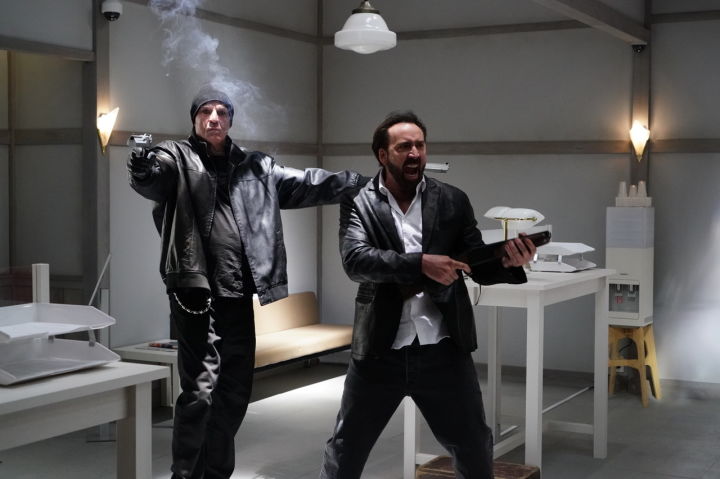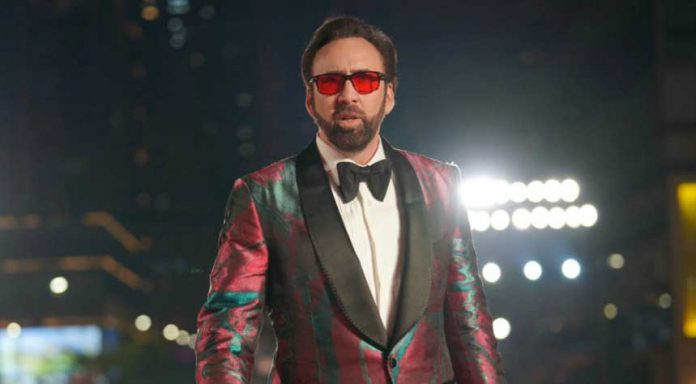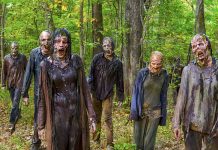Artnewspress :
If you’ve never seen a film or TV show directed by Sion Sono, titles like The Virgin Psychics or Tokyo Vampire Hotel should clue you in on his brand of genre exploitation. Prisoners of the Ghostland — starring, among others, Nicolas Cage and Sofia Boutella — feels right at home alongside other energetic Sono romps like Tokyo Tribe, the Japanese virtuoso’s 2015 post-apocalyptic gangland hip-hop martial arts musical. Ghostland brings together just as many genres and inspirations, which might make your average moviegoer perform a cartoonish spit-take when they’re listed back-to-back.The film is many things, from zany, post-apocalypse nightmare fuel, to a stylized mash-up of Western and Samurai cinema. It even occupies that specifically modern Nic Cage space born from unhinged commitment and debts to the IRS, riding a fine line between serious and tongue-in-cheek (Cage plays an imprisoned bank robber fitted with ball-threatening explosives and tasked with rescuing a young girl in a nuclear wasteland). And yet, none of these descriptors do justice to what the movie really feels like. If you’re in it for inventive action, there’s just enough of it to satisfy — though not nearly enough to blow you away — but Sono also made the film shortly after a life-threatening heart attack, which he claims killed him for 60 seconds and sent him hurtling through outer space. As fun as Prisoners of the Ghostland is, it’s also a dreamlike meditation on time.One of the first images we see is a gumball machine in the corner of a pristine, high-security Japanese bank. After a robbery gone wrong — Cage, simply referred to as “hero,” bursts in guns-a-blazing alongside sadistic partner “Psycho” (an unrecognizable Nick Cassavetes) — the gumballs spill to the floor in a chaotic mixture of glass and blood. It’s a mission statement of sorts, a prelude to the film’s candy-colored violence and cartoonish bloodshed. Soon after, the camera takes a trip through Samurai Town, a narrow locale with heightened artifice, whose saloon-harems are fitted with swinging wooden doors and traditional Japanese hanging lanterns. The town’s residents — some white, some Japanese, some belonging to other ethnicities — sport outfits either out of the Old West or feudal Japan. Whether a given character speaks English or Japanese feels randomly assigned, and the music cues sound like Ennio Morricone’s Spaghetti Western leitmotifs played on Japanese bamboo flutes.
When fearsome warlord The Governor (Bill Mosely, Repo! The Genetic Opera) arrives in search of Cage’s “hero,” the town gathers around him, welcoming him with coordinated chants. With handsome, katana-wielding right-hand man Yasujiro (Tak Sakaguchi) by his side, The Governor conscripts Cage into a rescue mission to find his missing granddaughter Bernice (Boutella) in exchange for his freedom, but the mission comes with some caveats in the form of Cage’s attire. He’s made to don intimidating black leather reminiscent of a bike gang — The Governor, standing in for Sono, dresses him this way because he likes the aesthetic — but the outfit is fitted with explosives on his arms, neck and testicles, which can be set off by the mere impulses to be violent or sexual in the presence of young women. It’s a means to protect Bernice from the one man capable of saving her, and it places Cage in an uncomfortable narrative predicament; the devices are bound to come into play, and bound to paint this “hero” in a rather untoward light. After all, Hollywood’s leading men are often defined by violence and sexuality (the latter was a key focus before Marvel subsumed the action blockbuster), so the blinking red lights on Cage’s neck and genitals pose a particular problem, in a film ostensibly about Hollywood imagery itself.
The film, after setting itself up as a rescue adventure, takes a couple of sudden left turns early on. It turns out finding Bernice isn’t a problem at all! Getting her to return willingly, however, ends up being the issue. In the meantime, she’s taken up residence — or been forced to; it’s left ambiguous — in an area called the Ghostland, a Mad Max-inspired dystopian desert township built around a clock tower, whose hands the residents lasso and desperately stop from moving forward. Bernice is encased, perhaps willingly, within the remnants of a mannequin, in a place where time is forced to stand still. Men who build engines and other devices used to move forward — like the delightful “Rat Man” and his rat clan — are considered outcasts.

The film is steeped in dream logic (or illogic) when it comes to spatial and emotional reasoning. The Ghostland isn’t so much its own township as it is a realm of specific cinematic influence, not unlike Samurai Town. The two places don’t seem to have any physical relationship to one another; whenever characters set out to travel between them, their view is subsumed by phantasmagorical images of a zombie prison bus and robotic samurai backed by an enormous mushroom cloud (no conversation about the history of America and Japan’s cyclical cultural influence is complete without the spectre of nuclear power). Instead, the connection between the two towns is a temporal one. Sono has long been influenced by eastern and western genre pictures, and Westerns and Samurai films have impacted each other’s plots and aesthetics for decades. Samurai Town, therefore, is a symbol of a lawless past (complemented by Cage’s haunted flashbacks of people he’s killed). The Ghostland, similarly, is a symbol of a hopeless future, and a place rife with Greek choruses who push the plot forward through call-and-response. The two places are on a collision course, but not for any reasons grounded in waking reality. They simply feel like extensions of Sono’s aesthetic fixations; it’s his dream about cinema, in a way.
Cage absorbs each new idea or piece of poetic dialogue with something halfway between wide-eyed fascination and mischievous acceptance. “The hero” knows what kind of movie he’s in, but he’s not really the hero of this story. He merely fits the aesthetic mold of a traditional hero, standing where a hero would stand, dressing how he would dress, rejecting and accepting the call to heroism in places where Joseph Campbell might take notice. If the story has a real “hero,” it’s Yasujiro, a relatively understated character with a more subtle moral and physical arc, but it’s hardly surprising to see Cage unhinge his jaw and swallow the picture whole. (His particular enunciation of the word “testicles” is worth the price of admission).
Verdict
With crowds and fight scenes imbued with the energy of genre musicals, Prisoners of the Ghostland makes for a particularly surreal tribute to the Western, the Samurai film, and the Mad Max post-apocalypse. You know exactly what brand of “weird” to expect from Nicolas Cage and Sion Sono, but what you might not expect is how much the film feels like a death dream about movies.
























